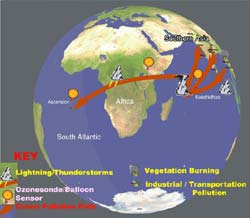Nasa Satellites And Balloons Spot Airborne Pollution "Train"

RIDING THE POLLUTION TRAIN <br> <br>The red arrows on this globe trace the fast track of ozone pollution from Asia as it contributes to the highest ozone episodes found in the South Atlantic. Asian smog with moderate amounts of ozone moves south into the Indian Ocean. Repeatedly, every few weeks, when this ozone can be swept upwards by tall rainclouds, it can then move eastward rapidly across Central Africa (upper arrow). The long red path is shown to end at Ascension Island, but actually a large patch of ozone fills much of the South Atlantic. Additionally, lightning and vegetation burning over Africa could add highly visible "pollution peak" features, but these obvious nearby African sources tell only half the story of the Atlantic ozone episodes. CREDIT: NASA, MODIS image <br>
NASA scientists discovered pollution could catch an airborne “express train,” or wind current, from Asia all the way to the southern Atlantic Ocean.
Scientists believe during certain seasons, as much as half of the ozone pollution above the Atlantic Ocean may be speeding down a “train” track of air from the Indian Ocean. As it rolls along, it picks up more smog from air peppered with thunderstorms that bring it up from the Earth’s surface.
Bob Chatfield, a scientist at NASA’s Ames Research Center, Moffett Field, Calif. said, “Man-made pollution from Asia can flow southward, get caught up into clouds, and then move steadily and rapidly westward across Africa and the Atlantic, reaching as far as Brazil.”
Chatfield and Anne Thompson, a scientist at NASA’s Goddard Spaceflight Center, Greenbelt, Md., used data from two satellites and a series of balloon-borne sensors to spot situations when near-surface smog could “catch the train” westward several times annually from January to April.
During those periods of exceptionally high ozone in the South Atlantic, especially during late winter, researchers noticed Indian Ocean pollution follows a similar westward route, wafted by winds in the upper air. They found the pollution eventually piles up in the South Atlantic. “We’ve always had some difficulty explaining all that ozone,” Thompson admitted.
Seasonal episodes of unusually high ozone levels over the South Atlantic seem to begin with pollution sources thousands of miles away in southern Asia,” Chatfield said. Winds are known to transport ozone and pollutants thousands of miles away from their original sources. Clearly defined individual layers of ozone in the tropical South Atlantic were traced to lightning sources over nearby continents. In addition to ozone peaks associated with lightning, high levels of ozone pollution came from those spots in the Sahel area of North Africa where vegetation burned. However, even outside these areas, there was extra ozone pollution brought by the Asian “express train.”
The scientists pinpointed these using the joint NASA-Japan Tropical Rainfall Measuring Mission satellite to see fires and lightning strikes, both of which promote ozone in the lower atmosphere. Researchers also identified large areas of ozone smog moving high over Africa using the Total Ozone Mapping Spectrometer satellite instrument.
The scientists confirmed the movement of the smog by using sensors on balloons in the Southern Hemisphere Additional Ozonesondes (SHADOZ) network. A computer model helped track the ozone train seen along the way by the SHADOZ balloon and satellite sensors. The scientists recreated the movement of the ozone from the Indian Ocean region to the Southern Atlantic Ocean.
Their research results appear in an article in a recent issue of the American Geophysical Union’s Geophysical Research Letters.
The mission of NASA’s Earth Science Enterprise is to develop a scientific understanding of the Earth system and its response to natural or human-induced changes to enable improved prediction capability for climate, weather, and natural hazards.
Media Contact
More Information:
http://www.gsfc.nasa.gov/topstory/2004/0426pollutiontrain.htmlAll latest news from the category: Ecology, The Environment and Conservation
This complex theme deals primarily with interactions between organisms and the environmental factors that impact them, but to a greater extent between individual inanimate environmental factors.
innovations-report offers informative reports and articles on topics such as climate protection, landscape conservation, ecological systems, wildlife and nature parks and ecosystem efficiency and balance.
Newest articles

Parallel Paths: Understanding Malaria Resistance in Chimpanzees and Humans
The closest relatives of humans adapt genetically to habitats and infections Survival of the Fittest: Genetic Adaptations Uncovered in Chimpanzees Görlitz, 10.01.2025. Chimpanzees have genetic adaptations that help them survive…

You are What You Eat—Stanford Study Links Fiber to Anti-Cancer Gene Modulation
The Fiber Gap: A Growing Concern in American Diets Fiber is well known to be an important part of a healthy diet, yet less than 10% of Americans eat the minimum recommended…

Trust Your Gut—RNA-Protein Discovery for Better Immunity
HIRI researchers uncover control mechanisms of polysaccharide utilization in Bacteroides thetaiotaomicron. Researchers at the Helmholtz Institute for RNA-based Infection Research (HIRI) and the Julius-Maximilians-Universität (JMU) in Würzburg have identified a…



